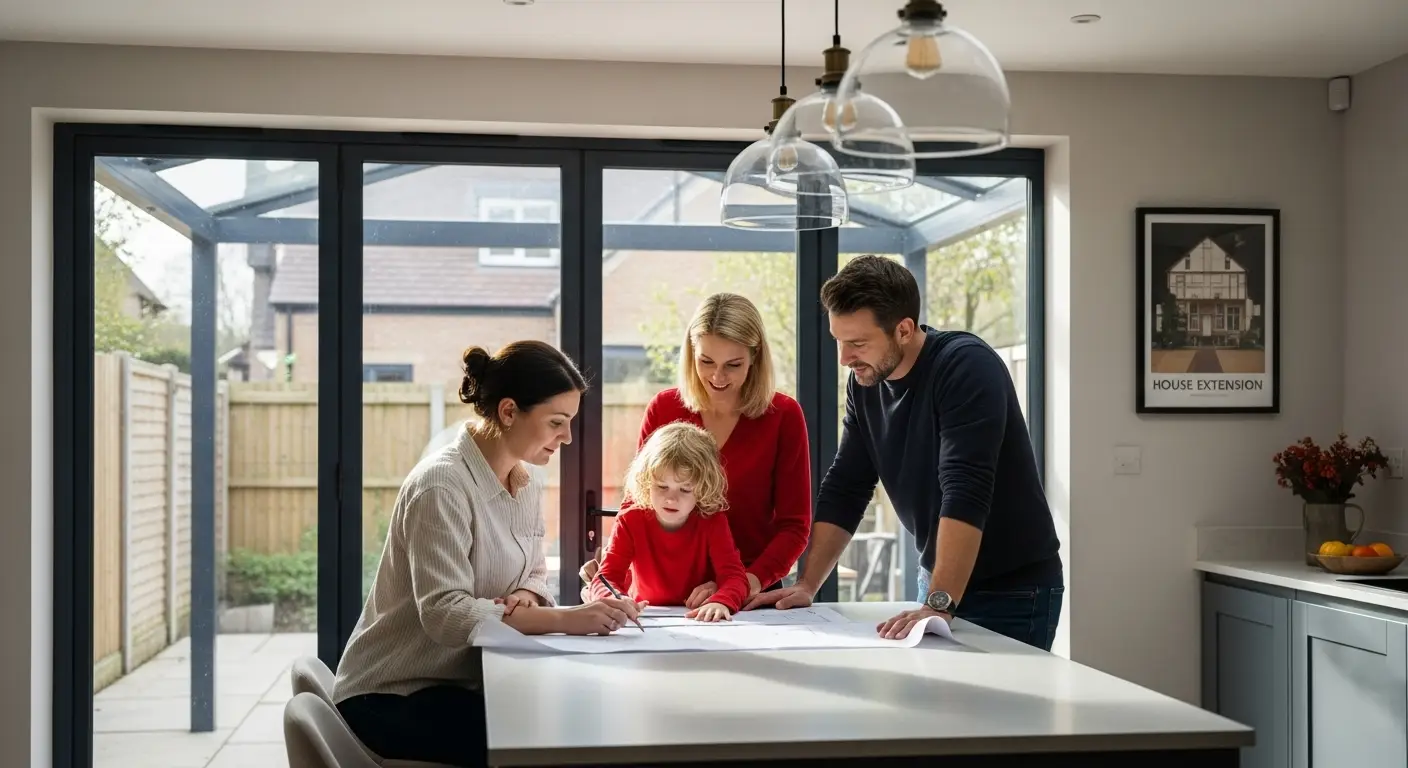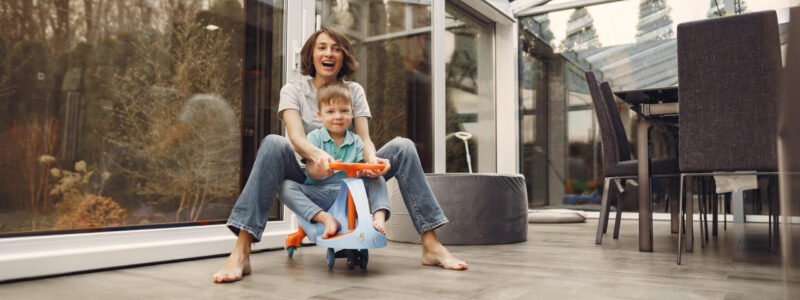Adding extra space to your home can be exciting and sometimes necessary. It might surprise you that a well-designed house extension can increase your property’s value by 10 to 20 percent. Yet, the most powerful advantage does not always come down to higher selling prices. It is the chance to reinvent your entire living space exactly as you need it right now.
Table of Contents
- What Is A House Extension And Why Consider One?
- Key Benefits Of House Extensions For Homeowners
- Understanding Planning Permissions And Legal Considerations
- Design Concepts For Effective House Extensions
- Exploring Different Types Of House Extensions
Quick Summary
| Takeaway | Explanation |
|---|---|
| House extensions increase property value | Extensions can boost market value by 10-20%, making them a beneficial investment. |
| Extensions accommodate growing family needs | They provide added space for family activities without the stress of relocating. |
| Permitted development rights streamline extensions | Many homeowners can extend their properties without needing full planning permission. |
| Prioritise architectural harmony in design | Successful extensions should match the existing structure’s aesthetic to maintain value. |
| Consider legal compliance for extensions | Ensure all necessary documentation and approvals are obtained to avoid legal issues. |
What is a House Extension and Why Consider One?
A house extension represents a strategic home improvement project where additional living space is created by expanding the existing residential structure. Unlike moving to a new property, extensions allow homeowners to transform their current living environment without the significant disruption and expense of relocation.
Understanding House Extensions
A house extension involves physically enlarging your current home by constructing new rooms or areas that seamlessly integrate with the existing building. These projects can range from modest single-storey additions to complex multi-level expansions. Our guide on home extensions explores the various types of potential modifications homeowners can undertake.
Typical house extension approaches include:
- Rear extensions creating additional kitchen or living space
- Side return extensions expanding narrow property spaces
- Wraparound extensions combining multiple architectural techniques
- Double-storey extensions providing substantial additional floor area
Compelling Reasons to Consider a House Extension
Homeowners pursue house extensions for multiple compelling reasons. According to Historic England, extensions offer significant opportunities to adapt living spaces to changing lifestyle needs without compromising the property’s existing character.
Key motivations typically include:
- Accommodating growing family requirements
- Creating additional functional living spaces
- Increasing property market value
- Avoiding costly and stressful relocation processes
- Personalising living environments to match specific design preferences
Extensions represent a smart investment strategy, allowing homeowners to enhance their property’s functionality and aesthetic appeal while potentially increasing its overall market value. By carefully planning and executing a well-designed extension, residents can transform their existing home into a more spacious, modern, and personalised living environment.
Key Benefits of House Extensions for Homeowners
House extensions offer homeowners substantial advantages beyond mere additional space, representing a strategic approach to property enhancement and lifestyle improvement. By carefully planning and executing an extension, property owners can unlock significant long-term benefits that extend well beyond immediate spatial requirements.
Financial and Property Value Advantages
One of the most compelling benefits of house extensions is their potential to increase property market value. Home extensions in Enfield demonstrate how strategic improvements can substantially boost residential property worth. According to research from the UK Parliament, well-designed extensions can provide a return on investment that often exceeds the initial construction costs.

Key financial benefits include:
- Potential property value increase of 10-20%
- Lower transaction costs compared to moving
- Enhanced marketability of the property
- Opportunity to customize investment in your home
Lifestyle and Functional Improvements
Beyond financial considerations, house extensions provide remarkable opportunities to transform living spaces to match evolving household needs. These modifications allow homeowners to create purpose-built areas that enhance daily living experiences, whether accommodating a growing family, establishing a home office, or designing dedicated leisure spaces.
Potential lifestyle enhancements include:
- Creating open-plan living areas
- Adding dedicated workspaces
- Generating additional bedrooms
- Developing multifunctional family zones
- Improving natural light and spatial flow
Ultimately, house extensions represent a sophisticated approach to home improvement. By thoughtfully expanding and reimagining living spaces, homeowners can simultaneously address practical requirements, boost property value, and create environments that genuinely reflect their personal lifestyle and aesthetic preferences.
Understanding Planning Permissions and Legal Considerations
Planning permissions represent a critical aspect of house extension projects, serving as the legal framework that ensures construction meets local authority standards and maintains neighbourhood architectural integrity. Navigating these regulations requires careful understanding and strategic planning to avoid potential legal complications.
Permitted Development Rights
Most residential extensions benefit from permitted development rights, which allow homeowners to expand their properties without full planning permission. Home extensions in Crouch End frequently leverage these rights to streamline the development process. According to the UK Planning Portal, these rights typically include specific parameters regarding extension size, height, and location.
Key permitted development characteristics include:
- Maximum rear extension depth of 3-4 metres for single-storey structures
- Height restrictions for single and double-storey extensions
- Limitations on total land coverage
- Requirements for maintaining architectural consistency
Legal Documentation and Compliance
Successful house extensions demand comprehensive legal documentation to ensure regulatory compliance. Homeowners must obtain necessary approvals and certificates, which validate the legality and safety of proposed construction work. The process involves multiple critical steps to demonstrate adherence to building regulations and local planning guidelines.
Essential legal documentation includes:
- Lawful development certificates
- Building regulation approval
- Party wall agreements
- Detailed architectural plans
- Structural engineering assessments
While permitted development rights offer significant flexibility, some extensions will require full planning permission. This typically occurs when proposed modifications exceed standard size limits, impact neighbouring properties, or are located in conservation areas. Professional consultation with local planning authorities helps homeowners understand specific requirements and navigate potential complexities in the extension approval process.
This table outlines the essential legal documents and permissions required when planning a house extension, clarifying their purpose and when each is typically necessary.
| Document/Approval | Purpose | When It Is Required |
|---|---|---|
| Lawful Development Certificate | Confirms compliance with permitted development rules | Most extensions under permitted rights |
| Building Regulation Approval | Ensures construction meets safety/building standards | All structural alterations |
| Party Wall Agreement | Resolves boundary building issues with neighbours | If work affects shared boundaries |
| Full Planning Permission | Formal approval for non-permitted development | Larger or restricted area extensions |
| Structural Engineering Assessment | Verifies structural integrity of proposed works | Major/complex extension projects |
Design Concepts for Effective House Extensions
Designing a successful house extension requires a sophisticated approach that balances architectural aesthetics, functional requirements, and seamless integration with the existing property. Thoughtful design goes beyond mere additional space, creating environments that enhance living experiences and complement the original building’s character.
Architectural Harmony and Material Selection
Successful extensions prioritize architectural continuity, ensuring the new space feels like a natural progression of the existing structure. Home extensions in Enfield demonstrate how careful material selection and design language can create cohesive architectural narratives. According to the National Design Guide, effective extensions should respect the original building’s identity while introducing contemporary functional elements.
Key considerations for architectural harmony include:
- Matching exterior material textures and colours
- Maintaining consistent architectural proportions
- Aligning roof lines and structural elements
- Preserving original building character
- Incorporating sympathetic design details
Functional Design and Spatial Planning
Beyond aesthetic considerations, effective house extensions demand meticulous spatial planning that maximizes usability and enhances overall living experiences. This involves understanding how different spaces interconnect, optimizing natural light, and creating flexible environments that adapt to changing household needs.
Critical functional design principles include:
- Creating seamless transitions between existing and new spaces
- Maximizing natural light through strategic window placement
- Designing multipurpose areas with flexible configurations
- Ensuring optimal thermal efficiency
- Considering long-term adaptability of the space
Ultimately, successful house extensions represent a delicate balance between architectural innovation and respectful restoration. By combining thoughtful design, high-quality materials, and a deep understanding of the property’s existing character, homeowners can transform their living spaces into remarkable, functional environments that exceed mere spatial expectations.

Exploring Different Types of House Extensions
House extensions represent a versatile solution for homeowners seeking to enhance their living spaces, with multiple architectural approaches tailored to diverse property configurations and individual requirements. Understanding the various extension types enables property owners to make informed decisions about expanding their homes strategically and efficiently.
Single-Storey Extension Configurations
Single-storey extensions offer flexible options for expanding ground floor living areas. Home extensions in Crouch End demonstrate the range of possibilities within this extension category. According to the Torbay Council’s House Extension Design Guide, these extensions can significantly transform interior spaces while maintaining architectural integrity.
Key single-storey extension variations include:
- Rear extensions creating additional kitchen or living space
- Side return extensions expanding narrow property areas
- Wraparound extensions combining multiple architectural techniques
- Conservatory and orangery style additions
- Lean-to extensions with contemporary glass designs
Multi-Storey and Specialist Extension Types
More complex extension approaches provide substantial spatial transformations for properties with specific structural characteristics. These advanced configurations enable homeowners to substantially increase their property’s usable area while addressing unique architectural challenges.
Specialist extension types encompass:
- Double-storey extensions generating significant additional floor space
- Dormer extensions creating additional upper-level rooms
- Loft conversions with integrated extension elements
- Basement extensions expanding underground living areas
- Modular extensions offering rapid construction solutions
Each extension type presents unique advantages, requiring careful consideration of architectural compatibility, local planning regulations, and individual household requirements. Successful extensions harmonise functional needs with aesthetic considerations, transforming properties into more spacious, adaptable living environments that reflect homeowners’ evolving lifestyles.
The following table summarises the main types of house extensions discussed in the article, comparing their key features and primary benefits to help homeowners understand their options more clearly.
| Extension Type | Key Features | Main Benefits |
|---|---|---|
| Rear Extension | Expands at the back of the property | Adds kitchen or living space |
| Side Return Extension | Utilises narrow side space | Maximises underused areas |
| Wraparound Extension | Merges side and rear extensions | Substantial ground floor expansion |
| Double-Storey Extension | Adds two floors, usually rear or side | Significant additional floor area |
| Dormer Extension | Grows upper levels, often within loft space | Creates extra bedroom or bathroom |
| Basement Extension | Expands living space below ground level | Increases usable area without altering exterior |
| Modular Extension | Pre-fabricated, rapid construction | Minimises disruption, quick installation |
Bring Your House Extension Vision to Life with Expert Support
Struggling to transform complex house extension guidance into real results? The article on the House Extension Design Guide highlights how navigating planning permissions, achieving architectural harmony, and ensuring full legal compliance often leave homeowners feeling overwhelmed. You deserve more than just generic advice—you need a bespoke solution that matches your ambitions and property constraints.
With over 20 years of specialist experience, our team turns these detailed planning and design concepts into stunning extensions across London and Surrey. From thorough support with planning permissions and legal documentation to seamless project management and clear, stage-by-stage pricing, we make the process as simple as possible. Looking for expert help designing the ideal rear, side, or double-storey extension? Start your transformation now. Get your questions answered or request a personalised quote through our contact page. Discover how easy it is to create a modern, functional space that meets every expectation—reach out today so we can help you move forward with confidence.
Frequently Asked Questions
What is a house extension?
A house extension is a home improvement project that involves expanding the existing structure to create additional living space, allowing homeowners to transform their current environment without relocating.
What types of house extensions are available?
There are several types of house extensions, including single-storey extensions, double-storey extensions, side return extensions, and wraparound extensions, each catering to different needs and property configurations.
Do I need planning permission for a house extension?
Most residential extensions may fall under permitted development rights, which allow certain expansions without full planning permission. However, some projects may still require approval, particularly if they exceed size limits or impact neighbours.
How can I ensure my house extension design is harmonious with my existing home?
To ensure architectural harmony, focus on matching exterior materials, maintaining consistent proportions, and aligning roof lines with the existing structure, while incorporating design elements that respect the original home’s character.





